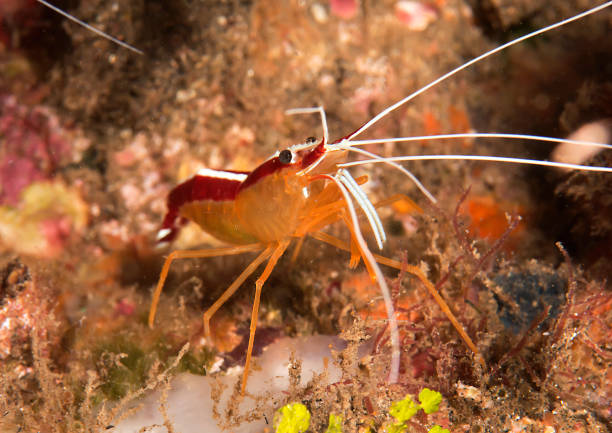ANIMAL: Scarlet Skunk/Pacific Cleaner Shrimp Lysmata amboinensis Type of Animal: Lysmatid Shrimp Habitat: In/around reefs/reef caves/reef ledges/reef crevasses at depths of 16-131 ft w/ cleaning areas on live rock/coral Location(s): Red Sea & Indo-Pacific Appearance: Pale amber body/legs, carapace (upper exoskeleton) has longitudinal bands, white spots on red/scarlet tail, 2 pairs of long white antennae, 10 pairs of walking legs w/ pincers on most anterior pair Food/Diet: Fish parasites/dead tissue, algae, detritus, carrion Status in Wild: Stable Conservation: Captive breeding reducing demand for wild-caught animals Lifestyle: Bonded pairs or loose colonies of 3-10 bonded pairs Additional Info: Called: Young: Nauplii/Zoea Group: Colony Gestation: 20 days Life Span: 3-5 years Body Length: Adult: 1-2.4 in Young: 0.32 in Main predators are hawkfish, pufferfish, lionfish, triggerfish, predatory shrimp, & crabs. Like other cleaner shrimp, they have mutualistic relationships w/ ‘client’ fish. Shrimp eat parasites/dead tissue from clients & clients benefit from parasite/dead tissue removal. To attract client fish, shrimp will perform rocking dance from side to side. These shrimp also called Skunk Cleaner Shrimp, Scarlet Cleaner Shrimp, White-Banded Cleaner Shrimp, Ambon Cleaner Shrimp, Northern Cleaner Shrimp, Amboina Cleaner Shrimp, Common Cleaner Shrimp, Ambon Shrimp, Whitestripe Cleaner Shrimp, Red Skunk Cleaner Shrimp, Indo-Pacific White-Banded Cleaner Shrimp, Humpback Cleaner Shrimp, Scarlet White-Striped Cleaner Shrimp, Red White-Striped Cleaner Shrimp, Scarlet Shrimp, Indo-Pacific White-Striped Cleaner Shrimp, & Pacific White-Striped Cleaner Shrimp among others. While loosely colonial, pairs guard small patches fiercely often killing intruders/rivals. Most often molt at night. In single spawning, shrimp will lay 200-500 eggs, initially attached to forked swimming limbs (pleopods). When eggs hatch, they hatch as larval nauplii then going into 2nd larval stage known as zoeae, then going through many free-floating planktonic stages (as many as 14 in which they molt until they reach 5 months old. Afterwards, they metamorphose into sub-adult form, which lasts for 1-3 months until reaching maturity, during which they go through several molts. Fun Fact(s): It’s believed these shrimp are color blind. When a diver’s hand is near area where cleaner shrimp are, they’ll give diver manicure. These shrimp used in public aquarium touch pools for same reason. Like other members of genus Lysmata, these shrimp hatch as males but after a few molts they’re hermaphroditic functioning as both sexes-there’s no pure female form in any member of this genus. All adults are hermaphroditic. 1 shrimp plays male role & other plays female role brooding fertilized eggs. When other shrimp molts, roles reverse.
